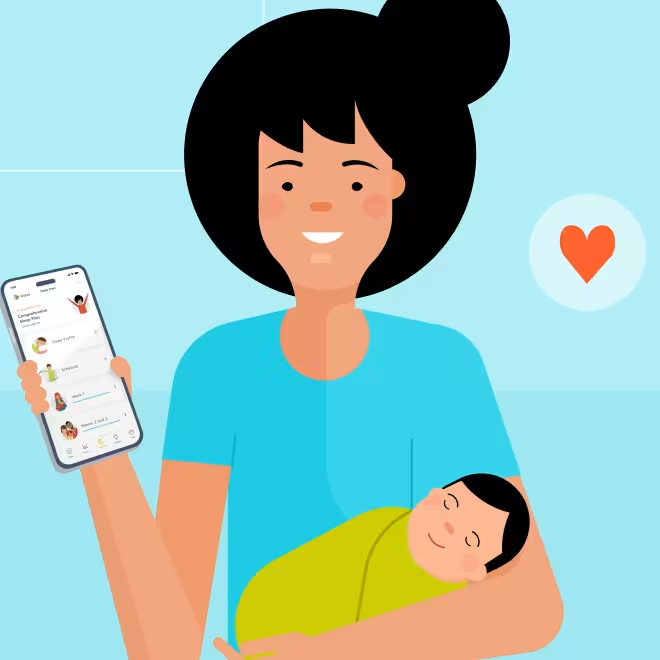Baby Sleep Tracker: How a sleep tracker helps you understand and improve your child’s sleep
Updated Nov 12, 2025
Parenthood often feels like wandering through a forest at night — magical, yes, but full of unknowns. You may still smell fresh pine and hear the songs of birds, but a lack of sleep can make the path hard to see. A tracker app, like Huckleberry, works like a lantern, highlighting the hidden trails of your baby’s bedtime rhythms.
In this article, we’ll walk you through why sleep tracking matters, how it works, tips for getting the most out of trackers, and exactly how Huckleberry can help you navigate your baby’s sleep.
Why sleep tracking matters
Sleep does more than recharge your baby. Research has found quality sleep lays the groundwork for a baby’s growth and development. It helps their little brains grow in ways that support memory, language, problem-solving, and decision-making.
For caregivers, too, better sleep may mean the energy (and motivation) to show up as the parent they want to be. In fact, parents notice a with better sleep. But when everyone’s exhausted, it can be hard to tell whether this is a phase or there’s a challenge that can be troubleshooted. That’s where tracking makes a difference.
By logging naps, overnight sleep stretches, and details about how your child fell asleep (e.g., on their own, while being fed, or held) sleep tracking helps you spot patterns you might miss in the day-to-day blur, like a baby who consistently wakes after one sleep cycle or who naps best at certain times. As patterns emerge over time, logging can help you adjust your child’s routines to help the whole family sleep a bit better.
Sleep tracking helps you:
Check nap timing and sleep length at a glance
See patterns like night wakings or
Understand when wake windows may be too short or long
Gauge when your baby is likely to be sleepy
Adjust the timing of before overtiredness sets in
Track how external factors (like or ) affect sleep
Spot progress in longer stretches of rest
Coordinate caregiving between parents with shared logs
Common sleep challenges that a sleep tracker can help identify
Sleep challenges are a normal part of childhood, but they can leave parents feeling tired, frustrated, or unsure how to help. A sleep tracker doesn’t solve these issues on its own, but it can help you spot patterns and trends that might otherwise be missed — giving you clearer information to work with when deciding what to try next or when to seek more guidance.
Every baby has their quirks, and sleep isn’t always predictable. Some common challenges a sleep tracker can help identify include:
Frequent waking
Many babies and young children wake multiple times throughout the night. A sleep tracker can give you clues as to whether the wakings are random or follow a predictable rhythm. If you spot a pattern, you can more easily troubleshoot, based on your baby’s age and needs.
Nap transitions
It often feels like once you figure out a good nap rhythm with your little one, something changes and sleep is thrown off again. During nap transitions, especially, children may flip-flop between schedules or skip naps altogether, which can affect mood, behavior, and nighttime sleep. Tracking nap timing and length can help you anticipate your little one’s sleep needs. For instance, spotting shorter naps or early wakes may pinpoint that your child needs a schedule change (like dropping a nap). Think of it as an extra supportive hand.
Difficulties falling asleep
Some children struggle to settle at bedtime, taking a long time to drift off. Parents can then experiment with calming activities or adjust bedtime schedules to make the transition smoother — keeping track of bedtimes can help parents understand if they should adjust timing.
Early rising
Waking too early can shorten total sleep and leave both children and parents tired. Spotting an early waking trend with a sleep tracker can help you experiment with different bedtimes, nap schedules, etc so your child gets the sleep they need.
Overtiredness
Overtired children often become fussy and have a hard time falling asleep and staying asleep. Tracking sleep time throughout the day allows parents to spot when their little one is approaching that tired (but not too tired) spot so sleep can be timed appropriately.
Are sleep trackers only for babies?
Sleep tracking can be very helpful in the baby phase and beyond. Whether it’s helping toddlers transition out of naps, guiding bedtime routines for preschoolers, or spotting early signs of sleep challenges in older kids, keeping tabs on your child’s sleep habits can be beneficial for ensuring they get the sleep they need and you can troubleshoot challenges as they arise.
With infants, tracking can feel more hands-on since you’re logging shorter and more frequent stretches of sleep. As children grow and settle into more predictable routines, tracking shifts towards bigger patterns like bedtimes or the timing of a single nap. It becomes less about tracking every detail and more about using it as a tool when specific challenges pop up.
How to use sleep trackers beyond the infant stage:
Keep track of when your child falls asleep and wakes up to spot trends (or changes from the norm)
Track naps if applicable for toddlers or preschoolers
See how naps affect nighttime sleep
Monitor sleep quality to see if restlessness or interruptions arise
Look for consistent habits that affect sleep
Use reports/patterns/information to tweak bedtime rituals, , or pre-sleep activities
How sleep trackers work
Sleep trackers give parents a clear window into their baby’s sleep routines, turning scattered moments into a bigger picture. The organized data can help you improve your routine in a manageable way.
With a sleep tracker you can:
Record how many hours your baby sleeps each day and night
Log and your baby’s mood while awake
Track timing, length, and consistency of daytime naps
Identify changes in sleep patterns, like shortened naps or
Expert tips for using sleep tracker apps
Tip #1: Aim for consistency — without stressing about perfection
Logging , wake times, and nighttime sleep can help reveal helpful patterns, especially when you do it regularly. But don’t worry if you occasionally miss an entry — what matters most is capturing enough information over time to notice trends. Think of tracking as a supportive guide, not something that needs to be perfect..
Tip #2: Review trends weekly (and in context)
Looking back once a week can help you spot shifts without getting caught up in the daily ups and downs. As you review, keep in mind that logs show timing and duration, not the full story. Pair what you see with your child’s mood, environment, and developmental stage.
Tip #3: Combine tracker insights with your broader approach
Sleep data is most useful when combined with consistent routines, parenting strategies, and your knowledge of your child. For example, if your tracker shows short naps, consider whether environment, feeding, or comfort factors also play a role — not just schedule.
Tip #4: Keep perspective
Sleep trackers are guides, not guarantees. They can highlight patterns you might miss, but they don’t predict every outcome. Use the information as one tool in your toolkit — alongside your instincts, your child’s cues, and, when needed, professional guidance.
How parents can use Huckleberry for sleep tracking
Huckleberry's tracking is intuitive, so you can focus on the sleep details that matter most. You can also customize your homepage to track other categories like feeding, diapers, or medicine, which can help identify changing sleep patterns or disruptions. ("Why am I so tired? Oh yeah, that early-morning blowout set our day an hour earlier. "🙃) Your logs sync instantly across devices, so partners, caregivers, or grandparents can stay up to speed. You can also set recurring or one-time reminders so nothing slips through the cracks. By keeping track in a single space, Huckleberry helps parents move from guessing and reacting to planning and supporting healthier sleep habits for the whole family.
And the best part? Tracking is a free feature within the Huckleberry app. With just a few taps, you can start creating a log of your baby’s sleep — a log that transforms into a plan for calmer days and longer nights.
Baby sleep tracker FAQ
Share article:
Note: The content on this site is for informational purposes only and should not replace medical advice from your doctor, pediatrician, or medical professional. If you have questions or concerns, you should contact a medical professional.




